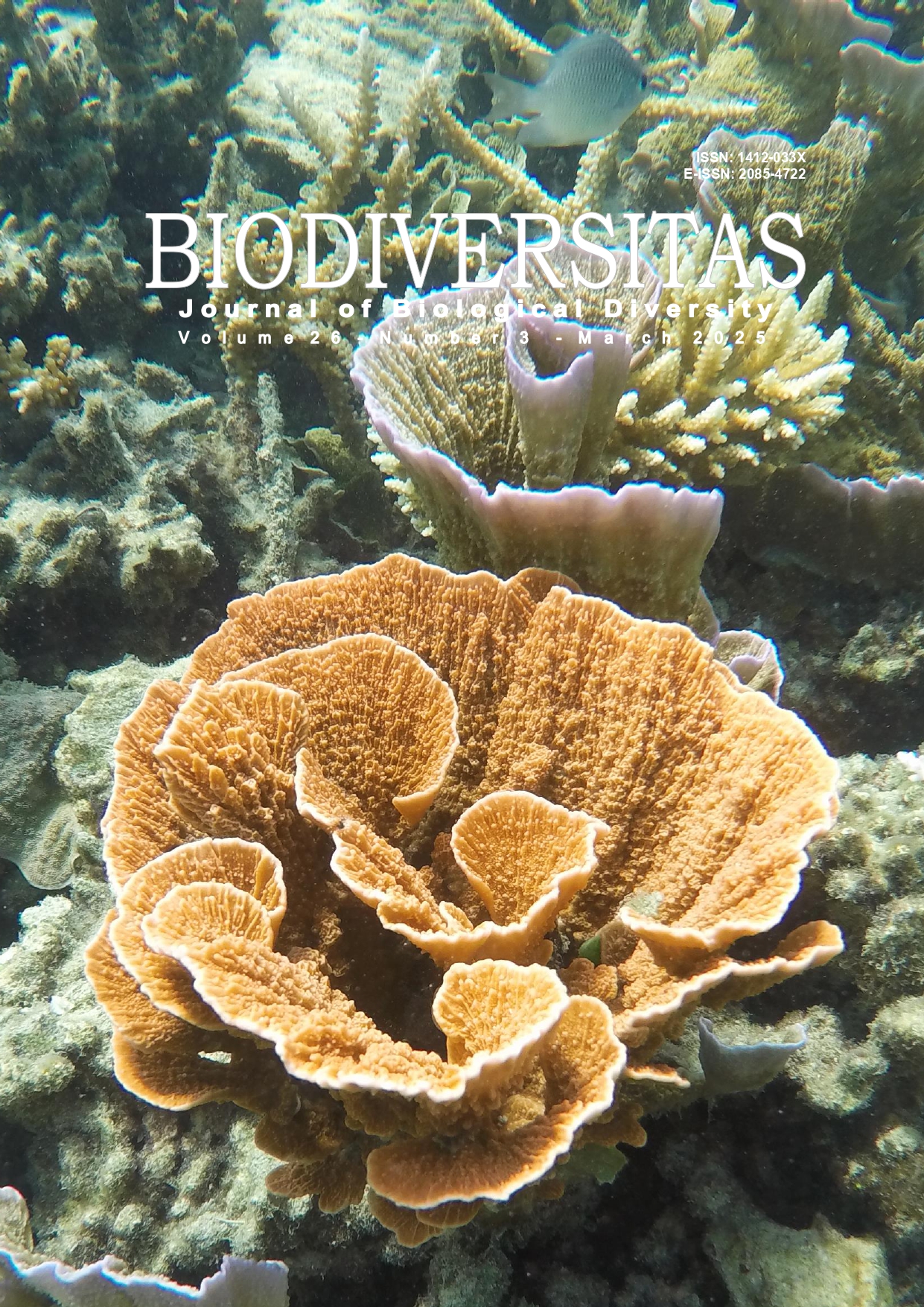Assessment of phosphate-solubilizing microbes isolated from indigenous organic-biofertilizers for enhancing plant growth in acid-stressed
##plugins.themes.bootstrap3.article.main##
Abstract
Abstract. Kamaluddin NN, Irwandhi, Arum P, Setiawan Y, Khumairah FH, Prihatiningsih N, Simarmata T. 2025. Assessment of phosphate-solubilizing microbes isolated from indigenous organic-biofertilizers for enhancing plant growth in acid-stressed. Biodiversitas 26: 1325-1333. Indonesia is one of the countries that produces enormous amounts of organic waste every year, but most of this organic waste has not been appropriately managed, thereby worsening climate change. One alternative solution that is environmentally friendly and sustainable is converting organic waste into Indigenous Organic Biofertilizers (IOB). This process involves the controlled decomposition of organic waste, which is then enriched with beneficial microbes, such as Phosphate Solubilizing Microbes (PSM). PSM from IOB can be a candidate for a biofertilizer inoculant that can withstand environmental stress, especially acidity stress caused by climate change. This research aimed to screen, characterize, and assess the biochemical activity of isolates and molecularly identify PSM from IOB that are resistant to acidity stress. In this research, characterization was carried out in the form of macroscopic and microscopic observations, resistance to acidity stress, phosphate dissolution index, production of Indole-3-Acetic Acid (IAA), compatibility test, and identification of the 16S rRNA gene. Bacterial isolates with codes F1ZN1, F2P, and F6P, while fungal isolates F4A, F5B, and F5C were the best PSM isolates. This isolate can produce IAA with a high category of around 57.28-105.94 ppm (bacteria) and a medium category of around 18.34-24.33 ppm (fungi). Apart from that, these isolates are compatible with the isolates to work synergistically. Through molecular identification of 16S rRNA sequencing, F1ZN1 was identified as Enterobacter cloacae strain Ec030, F2P was identified as E. cloacae strain UT25, and F6P was identified as E. cloacae strain ABRL064. These results highlight the potential of PSM isolates from IOB as an effective biofertilizer inoculant candidate for increasing plant growth in environmental stress (acidity) amidst climate change.
##plugins.themes.bootstrap3.article.details##
Most read articles by the same author(s)
- NUR PRIHATININGSIH, TRIWIDODO ARWIYANTO, BAMBANG HADISUTRISNO, JAKA WIDADA, Characterization of Bacillus spp. from the rhizosphere of potato Granola varieties as an antibacterial against Ralstonia solanacearum , Biodiversitas Journal of Biological Diversity: Vol. 21 No. 9 (2020)
- HERU ADI DJATMIKO, DHADHANG WAHYU KURNIAWAN, NUR PRIHATININGSIH, Potential of Bacillus subtilis potato isolate as biocontrol agent of Xanthomonas oryzae pv. oryzae and candidate for nanosuspension formula , Biodiversitas Journal of Biological Diversity: Vol. 23 No. 7 (2022)
- NUR PRIHATININGSIH, ARI ASNANI, HERU ADI DJATMIKO, Extracellular protease from Bacillus subtilis B315 with antagonistic activity against bacterial wilt pathogen (Ralstonia solanacearum) of chili , Biodiversitas Journal of Biological Diversity: Vol. 22 No. 3 (2021)
- LOEKAS SOESANTO, BISIRIL FATIHAH, ABDUL MANAN, ENDANG MUGIASTUTI, NUR PRIHATININGSIH , Organic control of Bemisia tabaci Genn. on Capsicum annuum with entomopathogenic fungi raw secondary metabolites , Biodiversitas Journal of Biological Diversity: Vol. 21 No. 12 (2020)
- IRWANDHI, NUR PRIHATININGSIH, SILVA ABRAHAM, MUHSON ISRONI, RIZKA GITAMI SATIVA, NADIA NURANIYA KAMALUDDIN, FIQRIAH HANUM KHUMAIRAH, HARIS MAULANA, EMMA TRINURANI SOFYAN, TUALAR SIMARMATA, Diversity of bacterial isolates as biocontrol agents against Fusarium oxysporum f. sp. lycopersici , Biodiversitas Journal of Biological Diversity: Vol. 25 No. 10 (2024)
- NUR PRIHATININGSIH, HERU ADI DJATMIKO, PUJI LESTARI, Endophytic bacteria associated with rice roots from suboptimal land as plant growth promoters , Biodiversitas Journal of Biological Diversity: Vol. 22 No. 1 (2021)
- NUR PRIHATININGSIH, RUTH FETI RAHAYUNIATI, HERU ADI DJATMIKO, PUJI LESTARI, NUR KHOLIDA WULANSARI, I KETUT WIDNYANA, KOKO DWI SUTANTO, Endophytic bacterial isolate diversity in suboptimal field rice and their potential in sheath blight control , Biodiversitas Journal of Biological Diversity: Vol. 25 No. 8 (2024)
- ESO SOLIHIN, DWI ANDREAS SANTOSA, BUDI NUGROHO, PURWONO, RIJA SUDIRJA, HARIS MAULANA, NADIA NURANIYA KAMALUDDIN, AGUNG KARUNIAWAN, SYAIFUL ANWAR, Selection for representative environment to identify high yielding and sweetness levels of sweet potato (Ipomoea batatas L.) in Indonesia , Biodiversitas Journal of Biological Diversity: Vol. 25 No. 1 (2024)
- HERU ADI DJATMIKO, NUR PRIHATININGSIH, PUJI LESTARI, Bioprospection of single and a consortium endophytic bacteria of suboptimal field rice isolates as biocontrol of rice bacterial leaf blight pathogens , Biodiversitas Journal of Biological Diversity: Vol. 24 No. 5 (2023)

